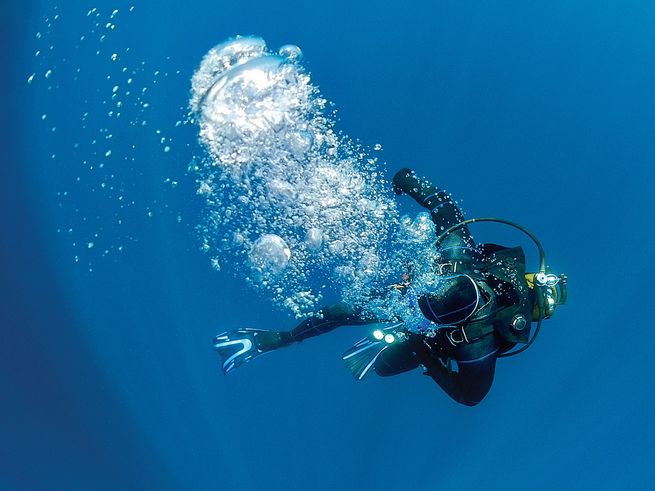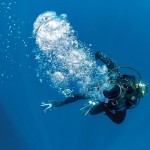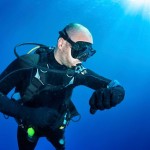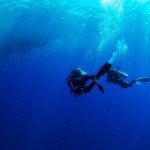We’ve rounded up 10 frequently asked questions by scuba divers — from surfacing with blood in your mask to exercising after a dive. Here are the answers.
FAQ #1
Is it safe to exercise after diving?
Studies have shown as much as a 34 percent increase in the incidence of decompression sickness in divers who exercised immediately after diving. Does that mean that other than the workout you get beneath the waves, you have to be a couch potato during your next dive vacation? Probably not, as long as you take it easy and don’t push yourself or your dive computer or tables. If you do exercise, make intelligent decisions about how soon after diving you’ll exercise, how strenuously you’ll exercise and for how long.
If you’re a physically fit and active 25-year-old who regularly plays tennis three days a week and you’ve made two fairly short, fairly shallow morning dives with a good surface interval in between, one set of tennis hours after your last dive is not going to push you over the edge. On the other hand, if you’re a sedentary 55-year-old and your vacation is the one week of the year when you’re physically active, you might be in trouble, especially if you’ve made long, deep dives.
FAQ #2
A buddy of mine told me I waste precious tank air every time I use my power inflator. Can I really conserve air by inflating my BC orally?
The better question may be: Can you save any air by orally inflating your BC?
The answer is a quiet “yes” with an emphatic “but” — and only when you’re above water.
It seems to make sense: you use exhaled air to inflate the BC and therefore save cylinder air. If you’re out of the water or on the surface, oral inflation will save cylinder air, but only a very small amount. And under water, oral inflation will actually increase your air consumption.
To inflate your BC orally under water, you have to change your breathing pattern and interrupt your life support, while keeping enough air in your lungs to clear the regulator for your next breath. In many instances, you’ll have to repeat the procedure several times: venting your lungs, pausing to check that you’ve added enough air to the BC, and possibly moving through the water or performing other tasks at the same time. In the process, you’ll end up expending more air-air that comes from your tank-than you saved.
Even on the surface, it makes more sense to keep your regulator in your mouth. Only inflate your BC at the surface orally if you are completely comfortable removing your regulator, and even then don’t expect any noticeable air savings. In short, use your power inflator, and save your breath.
FAQ #3
Why do I sink when I stop swimming along the reef?
When swimming underwater our bodies create lift, almost like an airplane’s wing. That’s the main reason we tend to sink when we pause — we need less buoyancy when we’re swimming. If you are neutral while swimming, usually taking a deeper breath or slightly tweaking the power inflator when stationary will be enough to compensate.
FAQ #4
I can’t find the boat. Should I surface?
The best way to handle this situation depends on a number of factors: How much air do you and your buddy have left? How strong is the current on the surface and at depth? Can you make a safety stop before surfacing? Do you have a compass so that you can take a reading to the boat on the surface and then swim back at depth?
Remember that if it’s not an emergency and you have enough air to do so, it’s usually prudent to make a safety stop before surfacing. If you’re going to surface to look for the boat, make your safety stop first. If you swim at 10 to 30 feet while searching for the boat for three minutes or more, then you have performed a safety stop.
There are a couple of good reasons for returning to depth for the swim back to the boat. For one, swimming on the surface is less efficient than swimming underwater — scuba fins are designed to function best when fully submerged. Also, currents are usually stronger on the surface than at depth.
On the other hand, depending on how far you are from the boat when you surface, you may not have enough air to make it back. And by swimming under water, you have to navigate and you’re more likely to miss the target.
If you find yourself in this situation, take all these factors into consideration and make the best decision you can. Compromising your decompression status shouldn’t be a problem unless you were dose to your no-decompression limits to start with and then go deeper than 30 feet for the swim to the boat. If you return to depth after less than 10 minutes on the surface, most dive computers will consider it part of the same dive — no harm, no foul.
FAQ #5
What should I do if my computer stops working during a dive?
In an ideal world, you would have brought your dive tables on the boat and you’d be calculating your pressure group during surface intervals in case your computer went kaput. Actually, in a really ideal world we wouldn’t need computers or dive tables or even regulators and ranks because we’d be able to breathe underwater and nitrogen wouldn’t affect us and we’d be able to eradicate prejudice and war and hunger by joining hands with everyone everywhere and jumping in the water in one great worldwide scuba diving love-in.
But in this world, your dive computer is still a machine and machines fail. And when it does, you should be ready to bail out, aborting the dive and reaching the surface safely. If you’ve been monitoring your computer regularly during the dive, you should have a good idea of where you stand with respect to decompression. If your dive buddy is diving with a computer and you’ve stayed close together throughout the dive, you may be able to use his computer to give you a general idea about your status. However, you should not share your buddy’s dive computer as if it were your own and continue to dive.
Assuming you were diving within the recreational limit of 130 feet, here’s the plan: First, assess the situation calmly, then move promptly to less than 60 feet. Step two: At 60 feet, slow your ascent rate to 30 feet per minute and move to 15 feet. Step three: Hang there and burn air. Over-decompressing is not a concern, but the opposite is. If the last reading of your computer or your buddy’s computer put you well in the clear, this hang should serve as an extended safety stop. No need to suck the tank dry, but if your decompression status puts you at risk, use all available air just to be sure.
FAQ #6
How do I know if my dive computer is liberal or conservative?
A dive computer’s algorithm, the complex mathematics behind someone’s theory of how decompression works, determines how liberal or conservative the computer is. The four base algorithms — usually tweaked and modified to varying degrees by manufacturers — are based on four different theories of how a diver absorbs and eliminates inert gases.
Are the most liberal dive computers reckless? Are the most conservative paranoid? Unfortunately, there’s no way to be sure, given the theoretical nature of decompression and individual factors such as fitness, cold, exertion levels and hydration that can affect a diver’s predisposition to decompression sickness.
Ultimately, it’s up to the diver to decide what constitutes a safe profile and to build in safety margins.
FAQ #7
I hear the “right-hand release” rule for weight belt buckles drilled into divers’ heads over and over again in certification classes and on dive boats. It’s not a big deal, but I’m left-handed, and a left-hand release is more natural for me. As long as my dive buddy and I know which way the belt is rigged, does it really matter?
The right-hand release rule is not a bad idea and it’s certainly taught with the best of intentions, but it is by no means the most important safety consideration related to the ditchability of the weight belt. More important is increasing the amount of training the divers get in weight use (particularly ditching), keeping a clear drop zone below the belt, and donning the weight belt so it’s the bottom belt with the BC belt above it.
Failure to ditch the weight belt is a serious problem in diving accidents — the majority of victims in fatal dive accidents are found with their weight belts still secured around their waists. However, there’s no evidence to suggest that this problem has anything to do with which direction weight belt buckles release.
So, if you want to wear your weight belt with a left-hand release, that’s OK. But also review weight-ditching procedures with your buddy, and make sure you know what to do if you ever find yourself in a situation where you need to ditch your weight.
FAQ #8
Is it safe to take a hot shower or jump in a hot tub after a day of diving?
Conservative physicians and decompression theorists have good reasons for warning divers away from participating in some activities soon after diving — things such as strenuous exercise, alcohol consumption and jumping into a hot tub. If you’re already pushing the edge of decompression sickness, they say, anything that can quickly and radically alter your physiology could potentially put you over the top. But there is no evidence to show that hot tubs have contributed to any actual cases of DCS.
Temperature can be a significant contributor to DCS, but extreme cold is more dangerous that hot-tub heat. In order for your core temperature to rise to a dangerous level, your outside temperature would be so high that you’d be very uncomfortable in the hot rub. As long as you can crawl out of the tub under your power, you’re probably OK.
FAQ #9
I surfaced with blood in the bottom of my mask. Should I worry?
You probably don’t need to seek treatment for a little blood in your mask at the end of a dive. It is an indication, however, that maybe you shouldn’t have been diving in the first place.
Like other body spaces, your sinuses must be equalized to match ambient pressure at depth during a dive to avoid potential complications. In most cases, blood in the mask indicates that you’ve tried to equalize too forcefully, probably due to congested sinuses.
As you descend with blocked sinuses, the pockets of air in your sinuses are compressed. There may be some pain until blood and other fluids from surrounding tissues flow into fill the remaining space. When you ascend, the air expands to fill the space again, pushing the accumulated fluids and blood into the nasal cavity. Voila! — Bloody mask.
There’s no real trick to equalizing your sinuses. Normally, air flows freely in and out of the sinuses, allowing pressure differentials to be equalized with little or no effort. But if the sinuses are blocked for any reason, it may be impossible to equalize those spaces to the surrounding pressure.
Sinus blocks are caused by allergic reactions, colds, upper respiratory infections and dried mucus. The best way to prevent nosebleeds and more serious sinus problems is to cancel your dive when you have a cold, an allergic reaction or when you suffer from a stuffy head. If you feel sinus pain on descent, you should abort your dive. Your sinuses will thank you.
FAQ #10
Other than decompression considerations, is there a reason that the diving community set 130 feet as an absolute limit on depth?
In the 1950s, the U.S. Navy set the depth limit for its divers at 130 feet primarily for the reason of human performance with the regulators of that era. At around 130 feet, the performance of regulators of that era would diminish significantly and the work of breathing would increase to the point that it became unsafe for divers to routinely go deeper.
The recreational diving community adopted the 130-foot limit established by the Navy as gospel, and it has since become as deeply ingrained in recreational diving as the commandment that prohibits holding your breath. But regulators have come a long way in the last 50 years, and there are now models that perform as well at 260 feet as they do at 130 feet. The original rationale behind the depth limit no longer applies. But does that mean you should head straight for 140 on your next dive? Not necessarily.
There are plenty of reasons to stay shallower. Very limited no-decompression times are a significant consideration for recreational divers, as is limited air supply. The deeper you go, the faster you get into decompression. The deeper you go, the faster you use your air. The deeper you go, the harder it becomes to make an emergency ascent. The deeper you go, the greater the chance of nitrogen narcosis. And the deeper you go, the more problems are magnified.
The fact is that for most recreational divers, including all those without advanced training, the depth limit should be less than 130 feet. For some divers with advanced skills, the 130-foot limit is appropriate. But for others, who have the skills, the equipment and the confidence, 130 feet shouldn’t be an absolute barrier just because they’ve always been taught that it is.
Source: Sport Diver











